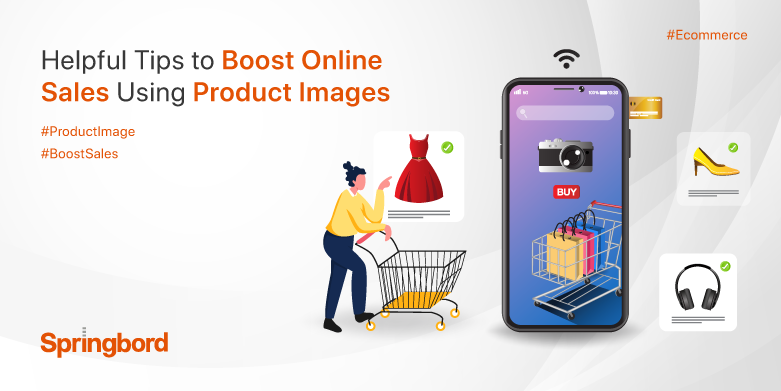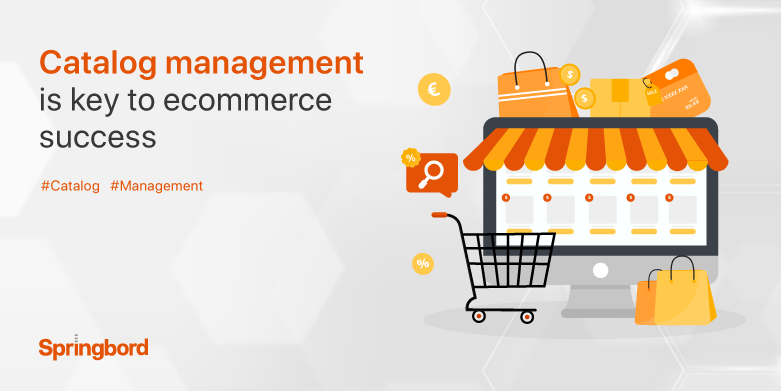 Read time 7 min
Read time 7 minIntroduction:
Pricing your products or services in the online marketplace is a delicate balancing act. Set your prices too high, and you risk losing potential customers to more affordable alternatives. Price them too low, and you may attract bargain hunters who don’t contribute significantly to your bottom line. Therefore, developing a well-crafted pricing strategy that considers market dynamics, customer perceptions, and your business objectives is vital for sustainable success.
At Springbord, we have honed our expertise in ecommerce pricing, helping numerous businesses navigate this complex terrain and achieve remarkable results. In this article, we will share valuable insights and actionable strategies to assist you in maximizing profits and sales through effective pricing.
Whether you operate a small boutique or a large online marketplace, these principles will empower you to make informed decisions and drive your ecommerce venture to new heights.
2. Understanding the Ecommerce Pricing Landscape
2.1 Ecommerce Market Dynamics
The ecommerce market is characterized by its dynamic nature, with constantly evolving trends and customer preferences. Business owners need to stay informed about market dynamics, such as emerging competitors, changing customer expectations, and shifts in industry pricing norms. By understanding the market landscape, businesses can position themselves strategically to maximize their profits and sales.
2.2 Key Challenges in Pricing Strategy
Ecommerce pricing presents several challenges that businesses must address. One such challenge is the complexity of pricing optimization due to factors like product variability, competition, and fluctuating demand. Additionally, the transparency of online prices makes it easier for customers to compare offers, putting pressure on businesses to provide competitive prices while maintaining profitability.
2.3 Importance of Pricing Optimization
Effective pricing optimization is essential for ecommerce businesses to maximize their profitability. A well-executed pricing strategy can enhance sales volumes, increase customer loyalty, and improve overall revenue. By carefully analyzing pricing data, businesses can identify patterns and make informed decisions to adjust prices and achieve optimal results.
3. Key Elements of Ecommerce Pricing Strategy
3.1 Cost-based Pricing
Cost-based pricing involves setting prices based on the production and operational costs associated with a product. By adding a markup to the cost, businesses can ensure they cover their expenses and generate profits. While cost-based pricing provides a baseline for setting prices, businesses should also consider other factors to remain competitive in the market.
3.2 Value-based Pricing
Value-based pricing takes into account the perceived value that a product or service offers to customers. By understanding the unique value proposition of their offerings and aligning prices accordingly, businesses can capture the willingness of customers to pay more for products that meet their needs and provide additional benefits.
3.3 Competitive Pricing
Competitive pricing involves setting prices based on the prices offered by competitors. This strategy aims to position a business in the market by offering prices that are on par with or lower than competitors. However, businesses should carefully analyze their cost structure and profit margins to ensure that competitive pricing does not compromise their profitability.
3.4 Dynamic Pricing
Dynamic pricing is a strategy that allows businesses to adjust prices in real time based on various factors, such as demand, supply, competitor prices, and customer behavior. By leveraging technology and data analytics, businesses can optimize their prices dynamically to respond to market conditions and maximize sales and profits.
3.5 Psychological Pricing
Psychological pricing relies on human psychology and perception to influence customer buying behavior. Strategies like setting prices just below a round number (e.g., $9.99 instead of $10.00) or offering tiered pricing options can create a perception of value and encourage customers to make purchases. Employing psychological pricing techniques can help businesses enhance their sales and profitability.
4. Maximizing Profits through Pricing Strategy
4.1 Pricing Elasticity and Demand
Understanding the price elasticity of demand is crucial for maximizing profits. Price elasticity measures the responsiveness of customer demand to price changes. By identifying price elastic and inelastic products in their portfolio, businesses can determine optimal pricing levels to maximize revenue. Elastic products may benefit from lower prices to drive sales volume, while inelastic products allow for higher prices to increase profit margins.
4.2 Price Optimization Techniques
Price optimization techniques involve leveraging data analytics to identify optimal pricing levels. By analyzing historical sales data, market trends, and customer preferences, businesses can develop pricing models that maximize profitability. Advanced algorithms and machine learning algorithms can help automate the price optimization process, ensuring accurate and timely adjustments.
4.3 Bundling and Upselling Strategies
Bundling involves offering multiple products or services together at a discounted price, encouraging customers to make larger purchases. Upselling strategies focus on persuading customers to buy higher-priced or premium versions of products. By implementing these techniques, businesses can increase their average order value and overall profitability.
4.4 Discounts and Promotions
Strategic use of discounts and promotions can be effective in driving sales and attracting new customers. Limited-time offers seasonal discounts, and exclusive promotions can create a sense of urgency and incentivize customers to make purchases. However, businesses should carefully evaluate the impact of discounts on their profit margins and ensure that promotions align with their overall pricing strategy.
4.5 Personalization and Customer Segmentation
Personalization and customer segmentation allow businesses to tailor pricing strategies to individual customer preferences. By analyzing customer data and segmenting them based on various criteria, such as purchasing behavior, demographics, or preferences, businesses can offer personalized pricing or targeted promotions. This approach enhances customer satisfaction and increases the likelihood of repeat purchases, ultimately maximizing profits.
5. Enhancing Sales with Effective Pricing Strategies
5.1 Price Perception and consumer behavior
Price perception and consumer behavior are intertwined factors that significantly impact sales. Understanding how consumers perceive prices can help businesses optimize their pricing strategies to drive sales. Factors such as the perceived value of a product, competitive pricing, and consumer psychology play vital roles in shaping consumer behavior. For example, a higher price might create the perception of exclusivity and quality, while a lower price might attract price-sensitive customers. By analyzing consumer behavior and adjusting pricing strategies accordingly, businesses can increase sales and revenue.
5.2 A/B Testing and experimentation
A/B testing and experimentation are powerful tools in the arsenal of ecommerce businesses. By testing different pricing strategies and measuring the outcomes, businesses can gain valuable insights into what works best for their target audience. A/B testing involves creating two or more variations of a pricing strategy and evaluating their performance. For instance, businesses can experiment with different pricing tiers, discounts, or bundling options. Through rigorous testing, businesses can identify the optimal pricing strategy that maximizes both sales and profits.
5.3 Cross-selling and product recommendations
Cross-selling is a technique where businesses promote additional products or services to customers based on their initial purchase. By leveraging cross-selling opportunities, businesses can increase their average order value and maximize sales. For example, when a customer adds a smartphone to their cart, the business can recommend compatible accessories, such as cases or screen protectors. By providing relevant product recommendations, businesses can enhance the customer experience and drive incremental sales.
5.4 Loyalty Programs and customer retention
Loyalty programs are an effective way to retain customers and drive repeat sales. By offering exclusive discounts, rewards, or special perks to loyal customers, businesses can incentivize repeat purchases and foster long-term customer relationships. Loyalty programs not only increase customer retention but also encourage customers to become brand advocates, leading to organic growth through word-of-mouth referrals. By incorporating loyalty programs into their pricing strategies, businesses can maximize profits and sales while building a loyal customer base.
5.5 Importance of data analytics in pricing decisions
Data analytics plays a critical role in pricing decisions. By harnessing the power of data, businesses can gain valuable insights into customer behavior, market trends, and competitor pricing. Analyzing historical sales data, customer preferences, and market dynamics enables businesses to make informed pricing decisions. Additionally, advanced analytics techniques, such as predictive modeling and machine learning, can help businesses identify pricing patterns and optimize their strategies for maximum profitability. Data-driven pricing decisions allow businesses to adapt to market changes and stay ahead of the competition.
6. Outsourcing Ecommerce Pricing Strategy
6.1 Benefits of outsourcing pricing strategy
Outsourcing an ecommerce pricing strategy offers several benefits to businesses. By partnering with a specialized pricing strategy provider, businesses can tap into their expertise and experience. These providers possess in-depth knowledge of pricing dynamics, market trends, and consumer behavior, enabling them to develop tailored pricing strategies for maximum profitability. Outsourcing pricing strategy also allows businesses to focus on their core competencies while leaving the pricing function to experts.
6.2 Expertise and industry knowledge
Outsourcing pricing strategy gives businesses access to professionals who possess specialized expertise and industry knowledge. These experts have a deep understanding of pricing methodologies, competitor analysis, and pricing optimization techniques. They can conduct thorough market research, analyze data, and develop pricing strategies that align with the business goals. By leveraging their expertise, businesses can implement pricing strategies that maximize profits and drive sales.
6.3 Cost-efficiency and resource optimization
Outsourcing pricing strategy can be a cost-effective solution for businesses. Instead of hiring and training an in-house pricing team, businesses can outsource the function to a provider who already has the necessary infrastructure and expertise in place. This approach eliminates the need for investing in additional resources and allows businesses to allocate their budget more efficiently. Furthermore, an outsourcing pricing strategy ensures scalability, as businesses can easily adjust the level of outsourcing based on their needs.
6.4 Choosing the right pricing strategy partner
When considering outsourcing pricing strategy, it is crucial for businesses to choose the right partner. Businesses should evaluate the provider’s experience, industry reputation, and track record. It is also important to assess the provider’s approach to data security and confidentiality, as the pricing strategy involves sensitive business information. By conducting thorough due diligence and selecting a trusted partner, businesses can outsource their pricing strategy with confidence.
Conclusion:
Crafting a winning pricing strategy is an ongoing process that requires careful analysis, adaptation, and a deep understanding of your target market. Springbord has outlined key principles and strategies to help you maximize profits and sales in the competitive ecommerce landscape.
Remember, your pricing strategy should be aligned with your business goals, brand positioning, and the value you deliver to customers. Continuously monitor market trends, stay attuned to customer preferences, and leverage data-driven insights to refine your pricing approach. By implementing these strategies and keeping a finger on the pulse of your ecommerce operations, you’ll be well-equipped to seize opportunities, overcome challenges, and achieve sustainable growth.
Springbord is committed to supporting your ecommerce journey by providing comprehensive solutions and guidance tailored to your specific needs. Together, let’s optimize your pricing strategy and propel your business to new levels of profitability and success.







